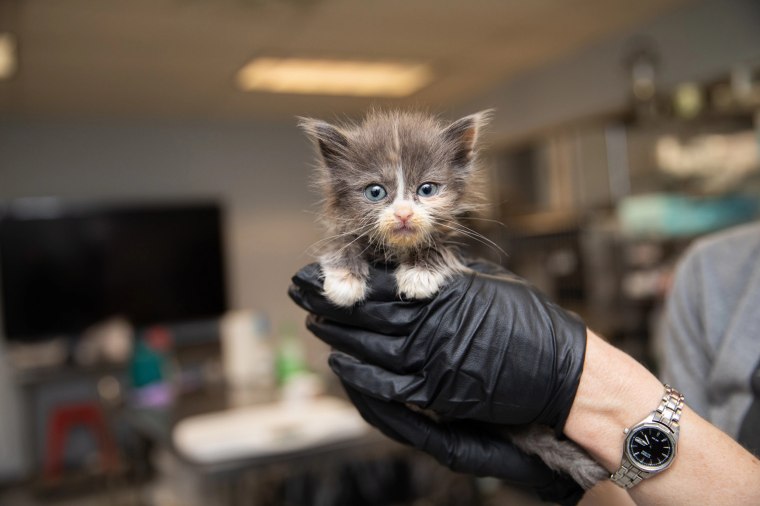How Many Animal Shelters Are In The Us
Creature shelters warn of a looming crunch and telephone call on Americans to help
Every bit nosotros enter the 3rd year of the coronavirus pandemic, a "perfect storm of factors" has put force per unit area on understaffed U.S. shelters.

When the onset of the coronavirus pandemic forced creature shelters beyond the country to shut their doors, Americans answered the drastic calls for help by adopting and fostering pets.
Now every bit we head into the third twelvemonth of the pandemic, a new crisis looms — so rescue advocates are hoping Americans volition stride upward to assistance in one case again.
Adoptions have slowed, and there are 100,000 more dogs and cats in shelters than this fourth dimension last year — which puts them at risk of euthanasia, co-ordinate to All-time Friends Animal Guild. The nonprofit also plant in a written report terminal summer that 87% of shelters surveyed reported being understaffed — and the omicron variant simply made the situation even worse.
Transport of pets from overcrowded shelters to areas with fewer adoptable pets has decreased — possibly because then many people are take a chance balky in the face of ongoing uncertainty — and pets who enter shelters are staying in longer, co-ordinate to Kristen Hassen, managing director of the nonprofit American Pets Live! and co-founder of Human Animal Support Services, an international collaborative of more than than 8,000 brute welfare professionals that began in response to the pandemic.
Plus, kitten flavor — the warmer months when cats start mating and their kittens flood shelters — is but about to start.
"We really do have a perfect storm of factors happening in shelters right now," Hassen told TODAY. "The great news is that people tin solve all of this."

There are two master ways the public can assist: past getting pets out of shelters through traditional methods like fostering, adopting, volunteering and donating — and by keeping pets out of shelters in the commencement identify.
For example, if we see a dog running loose, instead of calling animal command or a shelter, we can have them to a veterinarian to browse for a microchip and contact the owner (if at that place'southward no tag with a phone number to begin with). Or we tin keep them in our yard and put up signs in the neighborhood or post on the neighborhood social media site Nextdoor.
"Typically you can get pets dwelling the same day that they're lost, so information technology'due south not a large ask," Hassen said. "Merely it's 1 that makes a huge difference because 60% of animals entering shelters are lost or stray, and but about xv% of those are going home."
If information technology's no longer possible for a family to proceed a pet, instead of surrendering the animal to a shelter — where there's no way of knowing whether the pet lives or dies — she suggests finding the animal a new home.
Platforms like Rehome, Domicile to Dwelling and Go Your Pet are free to people looking to rehome their pets.

Fostering will be key to weathering this crisis as well as supporting shelters in the long term, Hassen believes. To conform this need, she hopes shelters will increment the number of foster coordinators that connect volunteers with foster pets. She points to the successful fostering initiatives of Atlanta's LifeLine Animal Project, which placed more than than seven,200 pets in foster homes in 2020.
"I feel both massive feet and I feel like we tin solve this," she said. "And so I do not feel hopeless — just concerned."

Heather Friedman, chief marketing officer for the Atlanta-based nonprofit LifeLine Creature Project, which manages two county shelters and a private shelter (in add-on to other services), said fostering has ever been a pillar of the group's lifesaving efforts, merely that the pandemic took it to the next level.
In 2019, 32% of LifeLine'due south shelter population went to foster homes; in 2020, it rocketed to 57%. The number of shelter pets in foster homes decreased to 44% in 2021, but the grouping hopes to get information technology back to at least fifty% and keep it at that place, according to Friedman.
"The increase in the number of foster homes over the past two years can, in part, be attributed to a shift to work from abode arrangements in the early on stages of the Covid-19 pandemic and the willingness of an amazing community of pet lovers to answer our calls for help," she told TODAY in an electronic mail.
Friedman said temporarily fostering pets before adoption helps overcrowded shelters as well as the pets themselves.
"When information technology comes to a pet's environment, at that place is no place like a dwelling house," she said. "We see such a transformation in shelter pets in one case they are in a home where they tin can decompress and let their personalities smoothen."

With this yr's kitten season in mind, Best Friends Beast Society developed a "kitten season campaign" to spread sensation of not merely the need for kitten fosters, but the joy it tin bring.
As viewers of this year'southward "Puppy Bowl" undoubtedly know, the nonprofit teamed up with Halle Berry and Caesars Sportsbook to create a spot featuring Drupe dressed as Cleopatra and laughing at the antics of adorable kittens frolicking on the flooring around her. "Foster a kitten — for real," she urges.
Holly Sizemore, primary mission officeholder at All-time Friends, said kitten fostering is "hilarious" and a fun manner to save lives — and necessary, since roughly two cats are killed for every shelter dog.
Another powerful way to help is to intendance for community cats (formerly called "feral") through trap-neuter-return programs of shelters or rescue organizations, according to Sizemore.
"Communities with trap-neuter-return programs have seen a notable reduction in the number of cats inbound shelters and a significant improvement in cat save rates," she told TODAY. "In that location are a lot of groups that want to help y'all humanely trap cats and become them neutered and vaccinated and then that they tin go on to live their lives outdoors without reproducing."

She hopes that people considering adopting pets will go on an open mind about the type of size or breed they want when visiting shelters, and to understand that shelters are understaffed — and that many workers are wearied trying to keep upwardly with the constant challenges of the pandemic.
And so if a shelter doesn't remember about a potential adoption in a few days, be patient and don't surrender — call up, she urged.
Brute lovers can also support shelters and pets by encouraging loved ones to prefer from the local shelter, according to Sizemore.
"I call up for people who have maybe never had a pet, now's the time to think well-nigh getting one because they provide the kind of love and back up and unconditional love that you tin't really notice anywhere else," she said.
Source: https://www.today.com/pets/pets/pet-adoptions-slow-us-heads-3rd-year-pandemic-rcna17718
Posted by: haassobsell.blogspot.com

0 Response to "How Many Animal Shelters Are In The Us"
Post a Comment